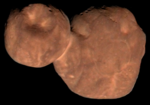astro.wikisort.org - Star
WD 0145+234 is a white dwarf star approximately 95 ly (29 pc)[3] from Earth in the constellation of Aries that has been associated with studies suggesting that a very large exoasteroid near the star was substantially disrupted, resulting in a considerable amount of dust and debris around the star.[3][5] Alternatively the outburst around WD 0145+234 is explained with ongoing collisions between planetesimals inside the dusty debris disk around the white dwarf.[6]
| Observation data Epoch J2000.0 Equinox J2000.0 | |
|---|---|
| Constellation | Aries[1] |
| Right ascension | 01h 47m 54.81s[2][3] |
| Declination | +23° 39′ 43.6″[2][3] |
| Apparent magnitude (V) | 11.64[4] |
| Characteristics | |
| Spectral type | DA[2] |
| Astrometry | |
| Distance | 98.08 ly (29.458[3] pc) |
| Details | |
| Temperature | 12910[2] K |
| Other designations | |
WD 0145+234; 2MASS J01475481+2339437; 1SWASP J014754.80+233943.8; Gaia DR2 291057843317534464; CHSS 3403; Mrk 362; WD 0145+23 | |
| Database references | |
| SIMBAD | data |
The outburst around WD 0145+234 appeared in 2018 in data by the Wide-Field Infrared Survey Explorer. Outburst around white dwarfs in the infrared are not unusual. Novae and dwarf novae also show outbursts, but they are accompanied by an outburst in the optical and appear around binaries. WD 0145+234 is however a single white dwarf and did not show any brightening in the optical images taken by CRTS and ASASSN. This suggested that the outburst was caused by recent replenishing or redistribution of dust.[3] A follow-up study using the Spitzer Space Telescope found a decrease of the infrared brightness, beginning in late 2019. The decrease is accompanied by small bumps superimposed on the decrease of infrared brightness. The team studying WD 0145+234 with Spitzer concluded that the increase of brightness was not caused by the a tidal disruption of an exoasteroids, but by ongoing collisions in the disk around the white dwarf. A similar decrease in infrared brightness was found around the white dwarf GD 56.[6] WD 0145+234 is also unusual because not only does it show metal pollution in the form of absorption lines, which are found around 25-50% of white dwarfs, but also emission lines caused by calcium gas, which are less common.[7] It is still not clear what causes the metal emission lines around some white dwarfs, but the existence of such lines around WD 0145+234 suggests that metal gas is formed in collisions. There are still some unanswered questions for this hypothesis: Some white dwarfs with metal gas show variable emission lines, while WD 0145+234 does not show any variability in the calcium emission line. It is unclear why some white dwarfs show variable metal emission lines.[6]
Other white dwarfs with planetary pollution also show infrared variability, with the prototype being G29-38, which showed a decrease of infrared flux by about 35% over a period of 300 days.[8] White dwarfs with the highest infrared variations show calcium emission lines, just like WD 0145+234.[9] WD 0145+234 might be the system with one of the highest activity of this class of objects.[6]

See also
- Disrupted planet
- List of stars that dim oddly
- Tabby's Star
- WD 1145+017
References
- Staff (2 August 2008). "Finding the constellation which contains given sky coordinates". DJM.cc. Retrieved 29 August 2019.
- Staff (2019). "WD 0145+234". SIMBAD. Retrieved 17 October 2019.
- Wang, Ting-gui; et al. (10 October 2019). "An On-going Mid-infrared Outburst in the White Dwarf 0145+234: Catching in Action of Tidal Disruption of an Exoasteroid?". arXiv:1910.04314v1 [astro-ph.SR].
- Staff (2019). "WD0145+234". Villanova University. Retrieved 17 October 2019.
- Letzer, Rafi (17 October 2019). "An Asteroid-Smashing Star Ground a Giant Rock to Bits and Covered Itself in the Remains". LiveScience. Retrieved 17 October 2019.
- Swan, Andrew; Kenyon, Scott J.; Farihi, Jay; Dennihy, Erik; Gänsicke, Boris T.; Hermes, J. J.; Melis, Carl; von Hippel, Ted (1 September 2021). "Collisions in a gas-rich white dwarf planetary debris disc". Monthly Notices of the Royal Astronomical Society. 506 (1): 432–440. arXiv:2106.09025. Bibcode:2021MNRAS.506..432S. doi:10.1093/mnras/stab1738. ISSN 0035-8711. PMC 8263348. PMID 34248393.
- Melis, Carl; Klein, Beth; Doyle, Alexandra E.; Weinberger, Alycia; Zuckerman, B.; Dufour, Patrick (1 December 2020). "Serendipitous Discovery of Nine White Dwarfs with Gaseous Debris Disks". The Astrophysical Journal. 905 (1): 56. arXiv:2010.03695. Bibcode:2020ApJ...905...56M. doi:10.3847/1538-4357/abbdfa. ISSN 0004-637X. S2CID 222208858.
- Xu, S.; Jura, M. (1 September 2014). "The Drop during Less than 300 Days of a Dusty White Dwarf's Infrared Luminosity". The Astrophysical Journal. 792 (2): L39. arXiv:1408.1618. Bibcode:2014ApJ...792L..39X. doi:10.1088/2041-8205/792/2/L39. ISSN 0004-637X. S2CID 118342404.
- Swan, Andrew; Farihi, Jay; Wilson, Thomas G.; Parsons, Steven G. (1 August 2020). "The dust never settles: collisional production of gas and dust in evolved planetary systems". Monthly Notices of the Royal Astronomical Society. 496 (4): 5233–5242. arXiv:2006.05999. Bibcode:2020MNRAS.496.5233S. doi:10.1093/mnras/staa1688. ISSN 0035-8711.
Другой контент может иметь иную лицензию. Перед использованием материалов сайта WikiSort.org внимательно изучите правила лицензирования конкретных элементов наполнения сайта.
WikiSort.org - проект по пересортировке и дополнению контента Википедии


